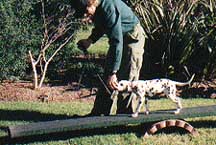Reinforcement
Reinforcement Dog Training.
One thing that can happen after a behavior occurs is that it can be rewarded or reinforced. Reinforcement, either positive or negative, makes a behavior stronger or more likely to occur again. A reinforcer is always determined by its effect on the behavior that preceded it. Technically reinforcement dog training could use either positive or negative reinforcement. Although most people are referring to positive reinforcement when talking about reinforcement training.
Positive Reinforcement
Reinforcement makes behavior increase when it adds something to the environment. If a behavior increases when followed by the addition of something to the environment – food, water, walks, or toys – we call this positive reinforcement.

Positive reinforcement can take many forms. Interaction with the family (pack) member can be very reinforcing, as can acquiring other basic needs. One type of social interaction many dogs find reinforcing is getting a family member’s attention
You can also reinforce your dog’s behavior by LOOKING at the dog or by TOUCHING or TALKING to the dog.
Some dogs find activities involving fixed action patterns, or drives the dog has been selectively bred for, inherently reinforcing. An example is playing retrieve for a dog with a high retrieve drive.
Negative Reinforcement
Some reinforcement makes behavior increase by removing something from the environment. If a behavior increases when followed by the removal of something – threatening objects, loud noises, or extreme heat – we call this negative reinforcement.
Like positive reinforcement, negative reinforcement for a dog can take many forms. Aggression is a behavior that is often successful at driving away or removing a part of the environment the dog is threatened by. Moving away or fleeing from a threat can also work at removing the threat. Moving away and avoiding the owner is often a dog’s reaction to a perceived threat. Reaching and grabbing at a dog can be perceived by the dog as a threat.
A dog’s most basic response to touch is defensive. To compound this many times people use threatening body language while trying to touch a dog. Sometimes humans want to show affection in a way that many dogs perceive as a threat or challenge.
Here are some social events the dog may try to remove from its environment: People LOOKING at the dog; TOUCHING the dog; or vocalizations (TALKING) to the dog. Do any of these sound familiar?
An observation I’ve made over the years is that this type of dichotomy is quite prevalent in the behavior of dogs. Therefore it is very important for us to be aware of the context of our own behavior and the behavior of our dogs. In this scenario know why you are looking at, touching, or talking to the dog.
Call 714-827-4058 today to get more information about my in-home dog training programs.
We provide training services to all of Orange County, Long Beach, the 562 area, and the San Gabriel Valley. I do offer convenient customized In home training to a large portion of Southern California’s most dog friendly communities.
Andrew Ledford
714-827-4058
